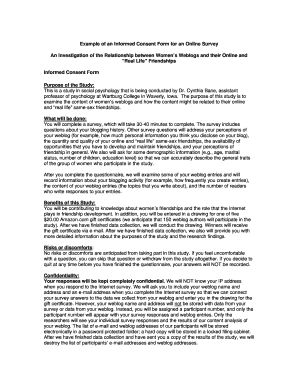Fill and Sign the Informed Consent Example 13701387

Valuable tips on organizing your ‘Informed Consent Example 13701387’ online
Are you weary of the inconvenience of handling paperwork? Look no further than airSlate SignNow, the leading eSignature platform for individuals and small to medium-sized businesses. Bid farewell to the tedious task of printing and scanning documents. With airSlate SignNow, you can effortlessly complete and sign documents online. Utilize the robust features embedded in this user-friendly and cost-effective system and transform your method of paperwork management. Whether you need to approve forms or gather signatures, airSlate SignNow takes care of it all with ease, requiring just a few clicks.
Follow this detailed guideline:
- Log into your account or register for a complimentary trial with our service.
- Click +Create to upload a document from your device, cloud, or our template library.
- Open your ‘Informed Consent Example 13701387’ in the editor.
- Click Me (Fill Out Now) to finalize the form on your end.
- Add and designate fillable fields for other participants (if necessary).
- Proceed with the Send Invite settings to solicit eSignatures from others.
- Download, print your copy, or convert it into a reusable template.
Don’t fret if you need to collaborate with your colleagues on your Informed Consent Example 13701387 or send it for notarization—our solution has everything you require to accomplish these tasks. Enroll with airSlate SignNow today and elevate your document management to a new standard!
FAQs
-
What is an Informed Consent Example?
An Informed Consent Example is a template or document that outlines the necessary information a participant needs to understand before agreeing to participate in a study or procedure. It ensures that individuals are fully aware of what they are consenting to, including risks and benefits. Using an Informed Consent Example can help streamline the consent process and enhance transparency.
-
How can airSlate SignNow help with Informed Consent Examples?
airSlate SignNow provides an easy-to-use platform for creating, sending, and eSigning Informed Consent Examples. With customizable templates, you can quickly generate consent forms that meet your specific needs. This not only saves time but also ensures compliance with legal requirements.
-
Is there a cost associated with using airSlate SignNow for Informed Consent Examples?
Yes, airSlate SignNow offers various pricing plans that cater to different business needs. You can choose a plan that fits your budget while still gaining access to features that allow you to create and manage Informed Consent Examples efficiently. A free trial is also available to explore the platform before committing.
-
What features does airSlate SignNow offer for managing Informed Consent Examples?
airSlate SignNow includes features such as customizable templates, automated workflows, and secure eSigning capabilities for Informed Consent Examples. Additionally, you can track document status and receive notifications when a consent form is signed. These features enhance the overall efficiency of the consent process.
-
Can I integrate airSlate SignNow with other tools for Informed Consent Examples?
Absolutely! airSlate SignNow offers integrations with various applications, including CRM systems and project management tools. This allows you to seamlessly incorporate Informed Consent Examples into your existing workflows, enhancing productivity and collaboration across your team.
-
What are the benefits of using airSlate SignNow for Informed Consent Examples?
Using airSlate SignNow for Informed Consent Examples provides numerous benefits, including increased efficiency, improved compliance, and enhanced security. The platform simplifies the consent process, making it easier for participants to understand and sign documents. Additionally, it helps businesses maintain accurate records of consent.
-
How secure is airSlate SignNow when handling Informed Consent Examples?
airSlate SignNow prioritizes security and compliance, ensuring that all Informed Consent Examples are handled with the utmost care. The platform employs advanced encryption and secure storage solutions to protect sensitive information. This commitment to security helps build trust with your participants.
Related searches to informed consent example 13701387
Find out other informed consent example 13701387
- Close deals faster
- Improve productivity
- Delight customers
- Increase revenue
- Save time & money
- Reduce payment cycles

